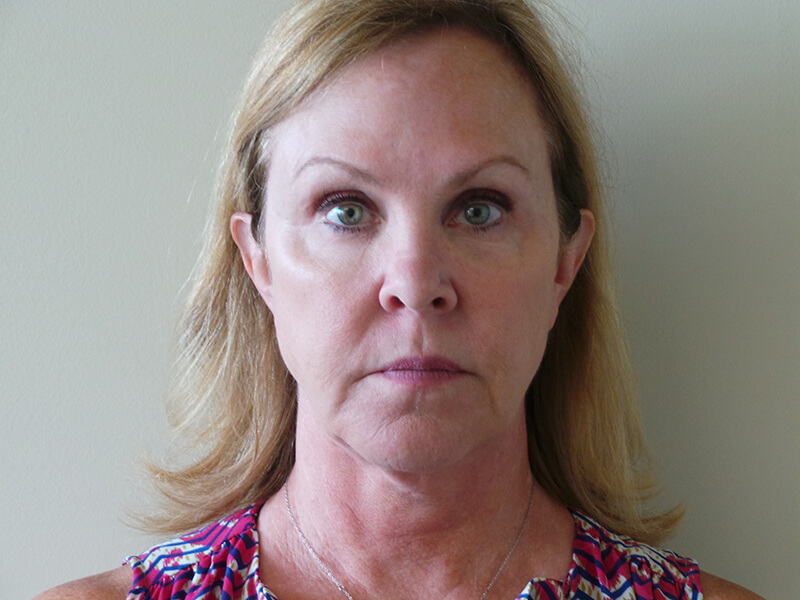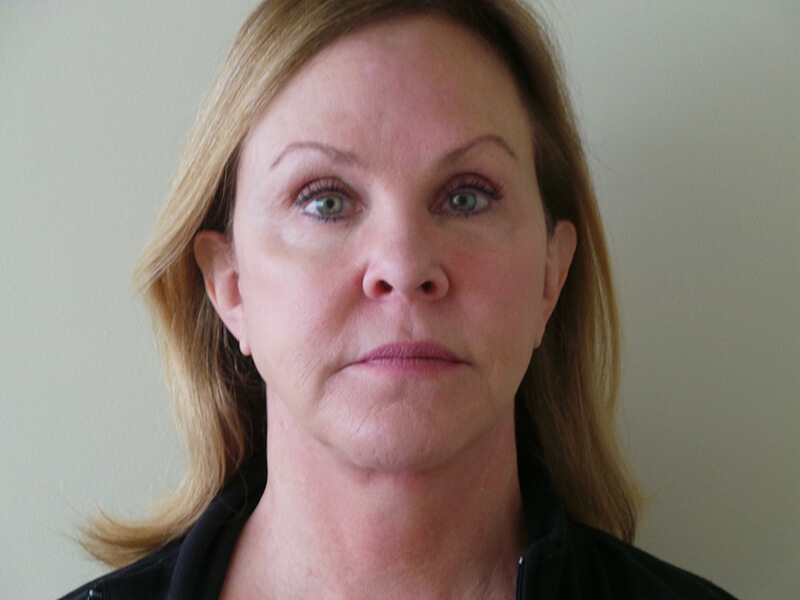
Facelift in Sacramento
Your Facelift Options
Traditional Facelift
A traditional facelift improves many visible signs of aging on the middle and lower regions of the face. This surgery removes excess skin and fat as well as tightening the muscles. Incisions extend from the hairline at the temples, down, around, and behind the ears where the tissues are tightened to reveal natural-looking youthfulness.
Mid-Facelift
Occasionally, time and gravity cause the cheeks to lose their suspension and fall towards the lower regions of the face. A mid-facelift procedure restores the cheeks to their youthful position with minimal risk of visible scarring using Dr. Mabourakh’s advanced surgical techniques.
Neck Lift
Neck lift surgery is combined with a facelift when significant jowls or vertical banding on the neck is present. Neck lift surgery involves removing excess fat and skin from the neck region through a small incision made beneath the chin. When performed in combination, a facelift and neck lift procedure produce balance and harmony between the facial features, creating the best results.
High SMAS and Deep Plane Facelift
Considering a facelift can be a big decision, so our team at Folsom Plastic Surgery wants to make sure you get all the information you need. Our board-certified plastic surgeon, Dr. Mabourakh, offers traditional and advanced facelift techniques, like high SMAS and deep plane facelifts, to give our patients a full spectrum of options for beautiful facial rejuvenation.
Dr. Mabourakh has a unique ability to create natural-looking results while dramatically enhancing skin smoothness, firmness, and facial definition. High SMAS and deep plane facelifts are two of the most popular facelifts we offer.
High SMAS Facelift
The high SMAS (superficial musculoaponeurotic system) facelift treats the deeper layers of facial tissue, not just the skin. It targets the tissue layer between the muscles and skin. The SMAS layer plays a key role in creating facial expressions, so it’s also a factor in wrinkling.
Benefits of a High SMAS Facelift
The high SMAS facelift is a specialized procedure that elevates and redistributes sagging soft tissue evenly throughout the midface, lower face, and neck.
This approach improves soft-tissue balance in these areas, addressing problems like jowling and sagging skin to create a fresh-looking facial rejuvenation. A high SMAS facelift can give you a youthful appearance that still looks natural.
The High SMAS Facelift Procedure
In the high SMAS facelift procedure, Dr. Mabourakh makes incisions near the hairline, lifts the skin, and tightens the deeper SMAS layer.
Ideal Candidates for a High SMAS Facelift
The ideal candidate for a high SMAS facelift experiences cheek, midface, and lower face sagging but still has some skin elasticity. You need to be in good general health.
Comparing High SMAS Facelift with Other Techniques
Unlike traditional facelifts that focus on lifting the skin, the High SMAS Facelift addresses the underlying muscles and fat. This produces a very natural look.
Because it targets deeper structures, the results of a High SMAS Facelift tend to last longer than those of a traditional facelift. However, no facelift is permanent.
Dr. Mabourakh determines whether a high SMAS facelift versus traditional facelift or another option, like a deep plane facelift, is right for you during your consultation. A deep plane facelift is another method that addresses the deeper tissue layers. It goes even deeper, below the SMAS layer, for a comprehensive rejuvenation.
A high SMAS facelift could be right for you if you want a more complete result than a regular facelift can provide.

Deep Plane Facelift
A deep plane facelift involves lifting and repositioning the deeper tissues of the face for comprehensive facial rejuvenation. This method goes even deeper into the face than the high SMAS lift.
Dr. Mabourakh repositions and refines the muscles and ligaments beneath the SMAS with this method.
Benefits of a Deep Plane Facelift
A deep plane facelift minimizes the amount of skin tension needed for the surgery. This reduces the risk of a “pulled” look and helps you get the most natural-looking results. Because the surgery involves a deeper correction, it offers long-lasting (though not permanent) results.
The Deep Plane Facelift Procedure
In a deep plane facelift, Dr. Mabourakh lifts your skin and deeper facial tissues as one unit. He repositions the skin and SMAS layer, and also anchors the deep facial ligaments in a higher position.
This technique reduces sagging in the cheeks, jawline, and neck, restoring youthful facial contours.
Ideal Candidates for a Deep Plane Facelift
Deep plane facelifts might be ideal for patients struggling with deeper lines and skin sagging. As with any plastic surgery, you need to be in good general health.
Comparing Deep Plane Facelift with Other Techniques
Deep plane facelift is the most comprehensive type of facelift. It offers the most in-depth correction possible.
Both deep plane facelift and high SMAS facelift excellent results that go deeper than a traditional facelift. Dr. Mabourakh can help you decide which option is right for you.
We can’t wait to hear from you
We are now offering virtual consultations.
Call today 916-984-8585


Facelift Patient Before & After
*Results of surgery will vary from individual to individual
Photo Gallery
Outstanding and professional care by Dr. Mabourakh and staff! I couldn’t be more pleased and praise Dr. Mabourakh for all of his efforts! The staff and Dr. Mabourakh could not have been more attentive to my after care needs, especially nurse Heather, to which I was so grateful. Thank you for everything!
What Do You Desire?
Smoother Skin
Fine lines, wrinkles, and sagging skin form as a result of aging, genetics, sun damage, and lifestyle choices. Facelift surgery improves the look of these imperfections to provide smoother skin and natural-looking results.
Firmer Neck
Sun damage, genetics, and weight fluctuations can result in significant skin laxity and excess fat in the neck area. Neck lift surgery involves removing excess fat deposits and loose skin to reveal a firmer, more youthful neck contour.
Facial Definition
Just as skin loses elasticity with age, so do the underlying muscles and facial fat. Facelift surgery repositions facial tissues to restore shape and definition.
Enhanced Confidence
Facelift surgery not only makes you look younger and more rejuvenated, but it can increase your confidence and self-image in social and professional settings. Facelift surgery highlights and enhances your natural beauty without changing who you are.

Concerns
Schedule a ConsultationRecovery
Facelift surgery is an outpatient procedure. You must have someone come with you to drive you home and provide assistance for the first day or so of recovery. Patients can expect their faces to be bruised, swollen, numb, tender, and tight. These are temporary and will fade within a few days or weeks. Minor dressings will be placed and are removed in 24 hours. Dr. Mabourakh avoids the use of drains during facelift and neck lift procedures. Patients are encouraged to be up and moving around the same day of surgery, but all strenuous activity should be avoided for at least two weeks. Most patients return to work within 7 to 10 days.
Scars
Traditional facelift incisions start at the hairline on the temples and extend in front of the ear and around to the back of the earlobe. Scarring can be minimized by avoiding direct sun exposure and applying silicone strips or gel. All scars fade with time and can be reduced with simple laser treatments in our office.
Cost
The cost of your facelift surgery will be determined by the methods used as well as whether or not any other cosmetic techniques are combined with the procedure. Additional cost factors include anesthesia, surgeon’s, and facility fees. You will receive a cost estimate during your consultation.
Pain
Facelift surgery is performed under local anesthesia with sedation or general anesthesia to ensure that there is no pain during the operation. Once the anesthesia wears off, patients can expect bruising, swelling, and numbness, all of which will improve with time. Pain is minimal and well-controlled with medication. Most bruising and swelling subsides within two or three weeks. Residual swelling may remain for a few months.
Frequently Asked Questions
-
What is the ideal age for a facelift?
Most patients who undergo facelift surgery are age 40 and above. That said, age does not play a significant role in determining your candidacy for facelift surgery. The quality of your skin and your bone structure are what matters, regardless of your age.
-
How long will my results last?
Most patients experience a noticeable reduction in fine lines and wrinkles for up to 10 years. While facelift surgery improves the appearance of facial aging, it does not stop the aging process; therefore, additional concerns will eventually resurface.
-
Am I a candidate for facelift surgery?
All men and women eventually experience some degree of facial skin laxity. Ideal candidates for facelift surgery include men and women whose facial and neck skin has begun to sag but still retains elasticity. Prospective patients should be in good overall health, be non-smokers, and have realistic expectations of their results.
-
What are the long-term risks and complications?
Complications after facelift surgery are rare and typically minor. Unfortunately, all surgeries come with inherent risk. These risks include:
- Adverse reactions to anesthesia
- Bleeding
- Infection
- Hematoma
- Nerve damage
- Changes in skin sensation
- Poor wound healing
You can reduce your risk of these complications by following all of Dr. Mabourakh’s pre- and post-operative instructions. This includes eating a healthy diet, limiting alcohol consumption, and avoiding the use of certain vitamins and medicines. Patients can also reduce the chance of complications by not smoking for at least three weeks before and two weeks after the surgery, as tobacco use significantly increases the chances of complications and poor wound healing.
-
Can other procedures be combined with facelift surgery?
Facelift surgery addresses aging and skin laxity on the middle and lower regions of the face. Patients commonly combine their facelift with a forehead (brow) lift or eyelid surgery to address aging on the upper part of the face. By combining procedures, Dr. Mabourakh can maintain balance and harmony between the upper and lower regions of the face.
-
Why should I choose Dr. Mabourakh for my facelift?
Dr. Mabourakh takes the time to listen to every patient’s desires, concerns, fears, and medical history. He evaluates every part of your face, skin, underlying muscles, and bone structure to ensure that the proper techniques are used. Dr. Mabourakh has certifications with the American Board of Plastic Surgery, the American Board of Surgery, and is a member of the American Society of Plastic Surgeons and the American Society for Aesthetic Plastic Surgery.
